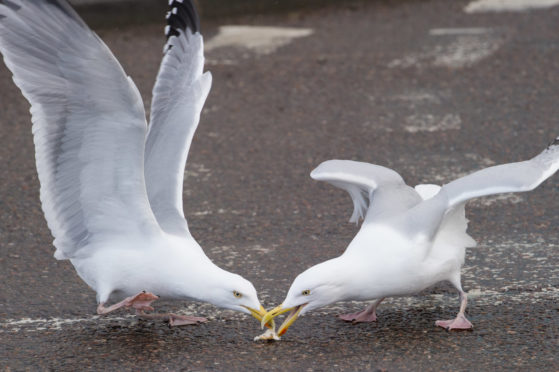I have a friend of an ornithological bent whose feathers are ruffled at the mention of seagulls.
There is no such bird, he sighs. There are the family of birds called gulls and terns and then there are the individual species, such as herring gulls, black-headed gulls, Arctic terms and so on, he’ll patiently and pedantically explain. But seagulls as a description is wrong, he claims.
In that case, I’m about to really annoy him. Because for the past few weeks I’ve been driven mad by the sound of seagulls.
Many of our towns and cities now have gulls nesting every year. The birds don’t know the difference between clifftops and the roofs of high buildings such as tenements. And, if there are easily accessed supplies of food around, thanks to human waste and littering, so much the better for them.
All day and all through the night our ears have been assaulted by a cacophony of screaming gulls. It’s particularly bad at this time of year, when the chicks are being fledged and adult birds are being territorial and protective of their young. A couple of years ago, work was being carried out on the roof of our building, and this discouraged seagulls from setting up home that season. We hoped it might have scared them off permanently but were dismayed when they returned the following year.
We’re not alone in our gull problem. Last month there was a report from Devon of a pet Chihuahua attacked and carried off by a seagull. A couple in Morecambe were virtually imprisoned in their home by gulls nesting on their roof which attacked them each time they left the house. The husband had to attend hospital for cuts to his head after one attack. Recently, the Royal Mail suspended deliveries to a street in Cornwall due to seagull attacks on posties.
There’s no dispute that the problem is worsening, with seagull populations in urban areas growing by an estimated 20% a year, and the average life span of a gull reaching close to 30 years. The colonisation of our towns and cities began in the 1940s, when herring and lesser black-backed gulls, the latter being the culprits in my particular area, began moving in. It’s thought that the problem was accelerated by the 1956 Clean Air Act which prevented local authorities from burning waste, with the consequence that discarded food and other organic material was simply dumped in landfill, creating handy avian takeaway food sources around most urban centres.
There are, in fact, seven distinct species of gull and five types of tern which breed in the UK. The most common, surprisingly, is the kittiwake which stays well clear of towns and cities, while the once-common herring gull is now in serious decline. In Scotland, it’s illegal to intentionally or recklessly injure or kill any gull or to damage or destroy a nest or its contents. So there’s no easy solution to the problem of birds which have become urban menaces.
Our ancestors weren’t so squeamish. I recently read a book about life in St Kilda, where the author reminisces about the taste of various seabirds, such as puffin and shearwater. Indeed, roast puffin is still considered a delicacy in Iceland. And people on the Isle of Lewis salivate at the thought of guga – young gannets harvested each year from Sula Sgeir. At this point I will declare an interest, having sampled guga. It was disgusting. And other more unlikely birds have been suggested as food sources – recently a Glasgow restaurant put young rooks on its menu.
So perhaps this could be the answer to our gull problem. It would of course be breaking the law, but it occurred to me that they could be a sustainable food source – with the positive side-effect of clearing away an annoying menace. However, although gulls are large birds, they’re mostly wings and feathers, with surprisingly little actual meat. I’d guess gull meat, like guga, is rather oily and fishy and would require considerable preparation before cooking. One historic recipe says the plucked and gutted bird should be boiled for a minimum of six hours, with the water discarded several times during the process. At the end of this time, the carcass should be taken and thrown in the dustbin.
Some societies were not so fussy. In the 19th century, the Chinese community in San Francisco employed a seagull trapper to keep them supplied with fresh gulls, which they considered a staple food. However, most coastal communities have historically ignored gulls and terns, other than collecting their eggs, suggesting that they’d tried cooking them and had discovered that it wasn’t worth the bother. So my plan for providing ourselves with a cheap food source while simultaneously solving an environmental problem appears to be going nowhere.
However, in my search for a recipe I did discover a German butcher who’d been caught trapping seabirds to put in his sausages. Police charged him for taking a tern for the wurst.
Campbell Gunn is a retired political editor who served as special adviser to two First Ministers of Scotland
